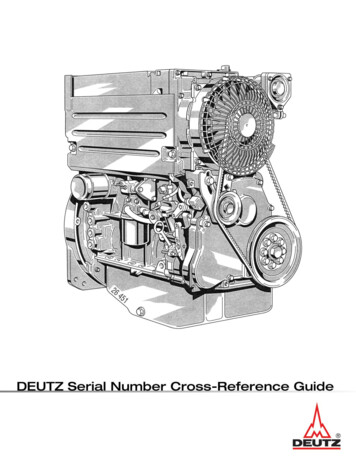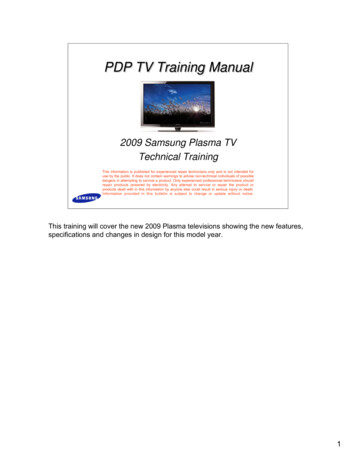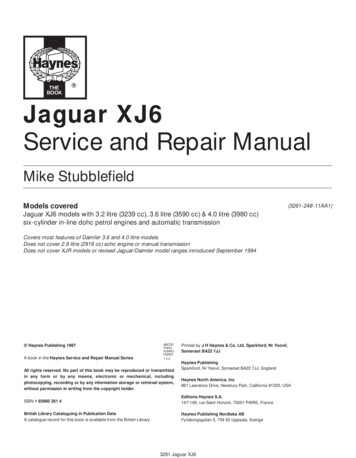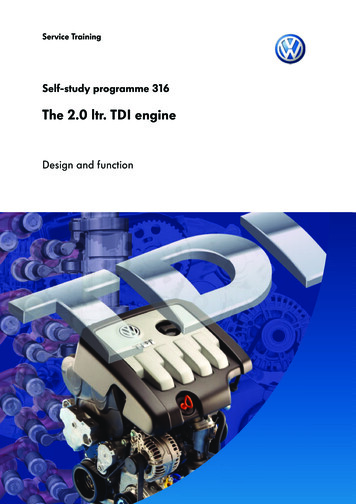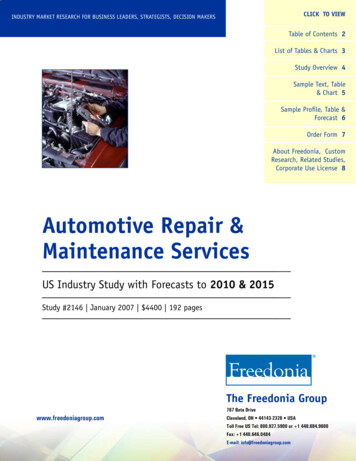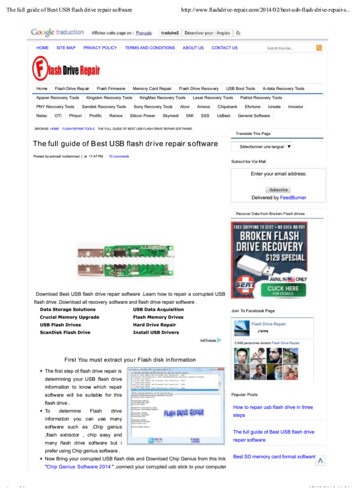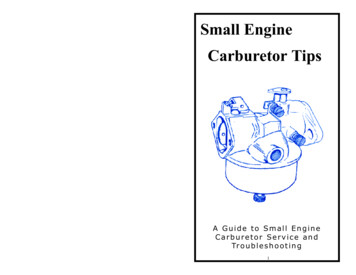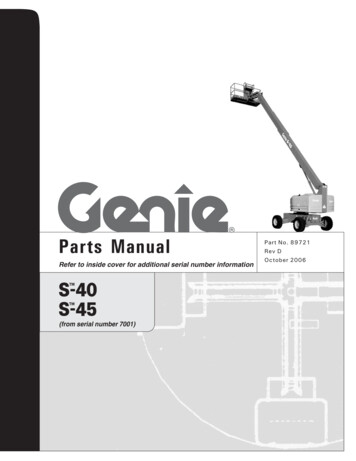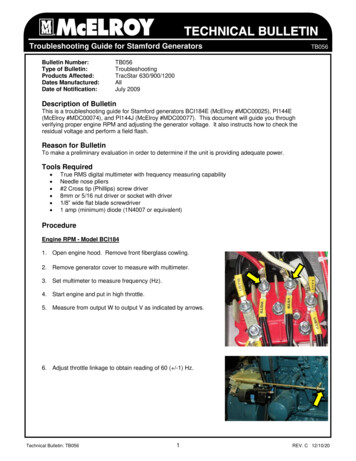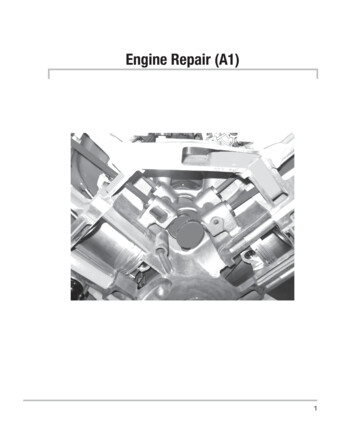
Transcription
Engine Repair (A1)1M01 HALD2866 03 SE ANS1.indd 105/01/19 10:09 AM
ENGINE REPAIR TEST CONTENT AREASThis ASE study guide for Engine Repair (A1) is divided into the sub-content areas that correlate to the actual ASEcertification test as follows:NUMBER OF QUESTIONSIN TESTCONTENT AREANUMBER OF STUDYGUIDE QUESTIONSA. General Engine Diagnosis1532 (1–32)B. Cylinder Head and Valve Train Diagnosis andRepair1043 (33–75)C. Engine Block Diagnosis and Repair1043 (76–118)D. Lubrication and Cooling Systems Diagnosis andRepair817 (119–135)E. Fuel, Electrical, Ignition, and Exhaust SystemsInspection and Service718 (136–15350153TOTALTIME ALLOWED TO TAKE THE TESTThe allocated time to take the Engine Repair Certification test is 75 minutes. ASE adds 10 additional questions to the test for research purposes. These questions do not count toward your score, but they are embedded within the test and there is no way ofknowing which ones do not count. As a result, the technician needs to answer 60 questions in 75 minutes, or about one questionper minute.If taking the recertification A1 test, there are just 25 questions with no additional research questions included. The time allocated to take the recertification test is 30 minutes, which means about one minute per question.BEFORE USING THIS STUDY GUIDEBefore trying to answer the questions and looking at the explanations, look over the following list of the content that ASE stateswill be covered in the certification test. For best results using this study guide, check service information or consult an automotivetextbook for details on any of the content areas that are not familiar before trying to answer the questions. For additional information about the ASE test, visit the website at www.ase.com.2M01 HALD2866 03 SE ANS1.indd 205/01/19 10:09 AM
ENGINE REPAIR (A1) CERTIFICATION TESTA. GENERAL ENGINE DIAGNOSIS (15 QUESTIONS)1. Verify the driver’s complaint and/or road-test the vehicle; determine needed action.2. Determine if the no-crank, no-start, or hard starting condition is an ignition system, cranking system,fuel system, or engine mechanical problem.3. Inspect the engine assembly for fuel, oil, coolant, and other leaks; determine necessary action.4. Listen to engine noises; determine needed action.5. Diagnose the cause of excessive oil consumption, coolant consumption, unusual engine exhaustcolor, odor, and sound; determine needed action.6. Perform engine vacuum tests; determine needed action.7. Perform cylinder power balance tests; determine needed action.8. Perform cylinder compression tests; determine needed action.9. Perform cylinder leakage tests; determine needed action.B. CYLINDER HEAD AND VALVE TRAIN DIAGNOSIS AND REPAIR (10 QUESTIONS)1. Remove cylinder heads, disassemble, clean, and prepare for inspection.2. Visually inspect cylinder heads for cracks, warpage, corrosion, leakage, and the condition of passages; determine needed repairs.3. Inspect and repair damaged threads where allowed; install core and gallery plugs.4. Inspect, test, and verify valve springs for squareness, pressure, and free height comparison; replaceas necessary.5. Inspect valve spring retainers, rotators, locks/keepers, and lock grooves.6. Replace valve stem seals.7. Inspect valve guides for wear; check valve stem-to-guide clearance; determine needed repairs.8. Inspect valves and valve seats; determine needed repairs.9. Check valve spring installed (assembled) height and valve stem height; determined needed repairs.10. Inspect pushrods, rocker arms, rocker arm pivots, and shafts for wear, bending, cracks, looseness,and blocked oil passages; repair or replace as required.11. Inspect and replace hydraulic or mechanical lifters/lash adjusters.12. Adjust valves on engines with mechanical or hydraulic lifters.13. Inspect and replace camshaft(s) (includes checking drive gear wear and backlash, end play, sprocketand chain wear, overhead cam drive sprocket(s), drive belt(s), belt tension, tensioners, camshaft reluctor ring/tone-wheel, and variable valve timing components).14. Inspect and measure camshaft journals and lobes; measure camshaft lift.15. Inspect and measure camshaft bore for wear, damage, out-of-round, and alignment; determine neededrepairs.16. Inspect valve timing; time camshaft(s) to crankshaft.17. Inspect cylinder head mating surface condition and finish; reassemble and install gasket(s) and cylinder head(s); replace/torque bolts according to manufacturers’ procedures.3M01 HALD2866 03 SE ANS1.indd 305/01/19 10:09 AM
C. ENGINE BLOCK DIAGNOSIS AND REPAIR (10 QUESTIONS)1. Disassemble engine block and clean and prepare components for inspection.2. Visually inspect engine block for cracks, corrosion, passage condition, core and gallery plug holes,and surface warpage; determine needed action.3. Inspect and repair damaged threads where allowed; install core and gallery plugs.4. Inspect and measure cylinder walls; remove cylinder wall ridges; hone and clean cylinder walls; determine need for further action.5. Visually inspect crankshaft for surface cracks and journal damage; check oil passage condition; measure journal wear; check crankshaft sensor reluctor ring (where applicable); determine needed action.6. Inspect and measure main bearing bores and cap alignment and fit.7. Install main bearings and crankshaft; check bearing clearances and end play; replace/retorque boltsaccording to manufacturers’ procedures.8. Inspect camshaft bearings for unusual wear; remove and replace camshaft bearings; install camshaft,timing chain, and gears; check end play.9. Inspect auxiliary (balance, intermediate, idler, counterbalance, or silencer) shaft(s) and support bearings for damage and wear; determine needed action.10. Inspect, measure, service, repair, or replace pistons, piston pins, and pin bushings; identify piston andbearing wear patterns that indicate connecting rod alignment problems; determine needed action.11. Inspect connecting rods for damage, alignment, bore condition, and pin fit; determine needed action.12. Inspect, measure, and install or replace piston rings; assemble piston and connecting rod; installpiston/rod assembly; check bearing clearance and sideplay; replace/retorque fasteners according tomanufacturers’ procedures.13. Inspect, reinstall, or replace crankshaft vibration damper (harmonic balancer).14. Inspect crankshaft flange and flywheel mating surfaces; inspect and replace crankshaft pilot bearing/bushing (if applicable); inspect flywheel/flexplate for cracks and wear (includes flywheel ring gear);measure flywheel runout; determine needed action.15. Inspect and replace pans, covers, gaskets, and seals.16. Assemble engine parts using formed-in-place (tube-applied) sealants or gaskets, according to manufacturers’ specifications; reinstall engine.D. LUBRICATION AND COOLING SYSTEMS DIAGNOSIS AND REPAIR (8 QUESTIONS)1. Diagnose engine lubrication system problems; perform oil pressure tests; determine needed action.2. Disassemble and inspect oil pump (includes gears, rotors, housing, and pick-up assembly); measureoil pump clearance; inspect pressure relief devices and pump drive; determine needed action.3. Inspect, test, and replace internal and external engine oil coolers.4. Fill crankcase with oil and install engine oil filter.5. Perform cooling system pressure tests; perform coolant dye test; determine necessary action.6. Inspect and test radiator, heater core, pressure cap, and coolant recovery system; replace as required.7. Inspect, replace, and adjust drive belt(s), tensioner(s), and pulleys.8. Inspect and replace engine cooling system and heater system hoses, pipes and fittings.9. Inspect, test, and replace thermostat, coolant bypass, and thermostat housing.10. Inspect and test coolant; drain, flush, and refill cooling system with recommended coolant; bleed airas required.11. Inspect and replace water pump.12. Inspect and test fan (both electrical and mechanical), fan clutch, fan shroud, air dams, and cooling fanelectrical circuits; repair or replace as required.13. Verify proper operation of engine-related warning indicators.4M01 HALD2866 03 SE ANS1.indd 405/01/19 10:09 AM
E. F UEL, ELECTRICAL, IGNITION, AND EXHAUST SYSTEMS INSPECTION AND SERVICE(7 QUESTIONS)1. Inspect, clean, or replace fuel injection system components, intake manifold, and gaskets.2. Inspect, service, or replace air filters, filter housings, and intake ductwork.3. Inspect turbocharger/supercharger; determine needed action.4. Test engine cranking system; determine needed repairs.5. Inspect and replace crankcase ventilation system components.6. Inspect and install ignition system components; adjust timing.7. Inspect and diagnose exhaust system; determine needed repairs.5M01 HALD2866 03 SE ANS1.indd 505/01/19 10:09 AM
ENGINE REPAIR (A1)CATEGORY: GENERAL ENGINE DIAGNOSIS1. Technician A says that oil should be squirted into all of the cylinders before taking a compression test.Technician B says that if the compression greatly increases when some oil is squirted into the cylinders, it indicates defective or worn piston rings. Which technician is correct?a.b.c.d.A onlyB onlyBoth A and BNeither A nor B2. Two technicians are discussing oil leaks. Technician A says that an oil leak can be found using a fluorescent dye in the oil with a black light to check for leaks. Technician B says that a white spray powdercan be used to locate oil leaks. Which technician is correct?a.b.c.d.A onlyB onlyBoth A and BNeither A nor B3. Technician A says that a worn (stretched) timing chain and worn gears will cause the valve timing tobe retarded. Technician B says that if the timing chain slack is over ½ inch (13 mm), the timing chainand gears should be replaced. Which technician is correct?a.b.c.d.A onlyB onlyBoth A and BNeither A nor B4. Leaking antifreeze can be what color?a.b.c.d.GreenOrangeRedAny of the above5. An increase in oil viscosity can be due to .a.b.c.d.wear metals in the oilfuel dilution of the oila clogged air filterany of the above6. Oil is discovered inside the air cleaner assembly. Technician Asays that the cause could be excessive blowby past the pistonrings. Technician B says that the cause could be a clogged PCVvalve, hose, or passage. Which technician is correct?a.b.c.d.Technician ATechnician BBoth A and BNeither A nor B6M01 HALD2866 03 SE ANS1.indd 605/01/19 10:09 AM
7. Two technicians are discussing the cause of low oil pressure. Technician A says that a worn oil pumpcould be the cause. Technician B says that worn main or rod bearings could be the cause. Whichtechnician is correct?a.b.c.d.A onlyB onlyBoth A and BNeither A nor B8. A noisy valve train is being diagnosed. Technician A says that therocker arm may be adjusted too tightly. Technician B says that therocker arm may be adjusted too loosely or may be worn. Whichtechnician is correct?a.b.c.d.A onlyB onlyBoth A and BNeither A nor ELADJUSTINGSHIMVALVECLEARANCECAMFOLLOWER(b)9. Two technicians are diagnosing a problem with an OHV V-8 with flat-bottom lifters. The valve covershave been removed and the engine is running. One pushrod is not rotating. Technician A says thatthe camshaft is worn and must be replaced. Technician B says that the lifter is worn and must bereplaced. Which technician is correct?a.b.c.d.A onlyB onlyBoth A and BNeither A nor B10. A head gasket failure is being diagnosed. Technician A saysthat an exhaust analyzer can be used to check for HC when the tester probe is held above the radiator coolant. Technician B saysthat a combustion tester liquid changes color in the presence of combustion gases. Which technician is correct?a.b.c.d.A onlyB onlyBoth A and BNeither A nor B11. Excessive exhaust system back pressure has been measured. Technician A says that the catalyticconverter may be clogged. Technician B says that the muffler may be clogged. Which technician iscorrect?a.b.c.d.A onlyB onlyBoth A and BNeither A nor B7M01 HALD2866 03 SE ANS1.indd 705/01/19 10:09 AM
12. Technician A says that black exhaust smoke is an indication ofa too-rich air-fuel mixture. Technician B says that white smoke(steam) is an indication of coolant being burned in the engine.Which technician is correct?a.b.c.d.A onlyB onlyBoth A and BNeither A nor B13. Technician A says that cranking vacuum should be the same as idle vacuum. Technician B says thata sticking valve is indicated by a floating valve gauge needle reading. Which technician is correct?a.b.c.d.A onlyB onlyBoth A and BNeither A nor B14. Two technicians are discussing a cylinder power balance test. Technician A says the more the engineRPM drops, the weaker the cylinder. Technician B says that all cylinder RPM drops should be within50 RPM of each other. Which technician is correct?a.b.c.d.A onlyB onlyBoth A and BNeither A nor B15. A cylinder leakage (leak-down) test indicates 30% leakage, and air is heard coming out of the air inlet.Technician A says that this is a normal reading for a slightly worn engine. Technician B says that oneor more intake valves are defective. Which technician is correct?a.b.c.d.A onlyB onlyBoth A and BNeither A nor B16. During a cylinder leakage (leak-down) test, air is noticed comingout of the oil fill opening. Technician A says that the oil filter maybe clogged. Technician B says that the piston rings may be worn ordefective. Which technician is correct?a.b.c.d.A onlyB onlyBoth A and BNeither A nor B17. The low oil pressure warning light usually comes on .a.b.c.d.whenever an oil change is requiredwhenever oil pressure drops dangerously low (3 to 7 psi)whenever the oil filter bypass valve openswhenever the oil filter anti-drain-back valve opens8M01 HALD2866 03 SE ANS1.indd 805/01/19 10:09 AM
18. Two technicians are discussing a compression test. Technician A says that the engine should becranked over with the pressure gauge installed for “3 puffs.” Technician B says that the maximum difference between the highest-reading cylinder and the lowest-reading cylinder should be 20%. Whichtechnician is correct?a.b.c.d.A onlyB onlyBoth A and BNeither A nor B19. A compression test gave the following results:cylinder #1 155, cylinder #2 140, cylinder #3 110, cylinder #4 105. Technician A says that adefective (burned) valve is the most likely cause. Technician B says that a leaking head gasket couldbe the cause. Which technician is correct?a.b.c.d.A onlyB onlyBoth A and BNeither A nor B20. An engine noise is being diagnosed. Technician A says that a double knock is likely to be due to aworn rod bearing. Technician B says that a knock only when the engine is cold is usually due to aworn piston pin. Which technician is correct?a.b.c.d.A onlyB onlyBoth A and BNeither A nor B21. Two technicians are discussing how to perform a road test to verify the customer’s concerns aboutnoise from the engine. Technician A says that the owner should drive and the technician ride alongto verify the problem. Technician B says that the vehicle should be driven next to a building to betterhear engine noise as it bounces off the walls. Which technician is correct?a.b.c.d.A onlyB onlyBoth A and BNeither A nor B22. An engine equipped with a turbocharger is burning oil (blue exhaustsmoke all the time). Technician A says that a defective wastegatecould be the cause. Technician B says that a plugged PCV systemcould be the cause. Which technician is correct?a.b.c.d.A onlyB onlyBoth A and BNeither A nor B23. An engine cranks rapidly but does not start. Technician A says that a defective coil on a waste-sparktype ignition could be the cause. Technician B says that a broken timing belt could be the cause.Which technician is correct?a.b.c.d.A onlyB onlyBoth A and BNeither A nor B9M01 HALD2866 03 SE ANS1.indd 905/01/19 10:09 AM
24. An engine uses an excessive amount of oil. Technician A says that clogged oil drain-back holes in thecylinder head could be the cause. Technician B says that worn piston rings could be the cause. Whichtechnician is correct?a.b.c.d.A onlyB onlyBoth A and BNeither A nor B25. Two technicians are discussing engine and transmission/transaxle mounts. Technician A says that adefective (collapsed) mount can cause an engine or driveline vibration. Technician B says that somemounts are fluid filled and should be checked for leakage. Which technician is correct?a.b.c.d.A onlyB onlyBoth A and BNeither A nor B26. An engine is misfiring. A power balance test indicates that when the spark to cylinder #4 is grounded,there is no change in the engine speed. Technician A says that a burned valve is a possible cause.Technician B says that a defective cylinder #4 injector or spark plug wire could be the cause. Whichtechnician is correct?a.b.c.d.A onlyB onlyBoth A and BNeither A nor B27. Technician A says that white exhaust can be caused by a defective cylinder head gasket allowingcoolant to enter the combustion chamber. Technician B says a leaking fuel injector can be the causeof white exhaust smoke. Which technician is correct?a.b.c.d.A onlyB onlyBoth A and BNeither A nor B28. Cranking vacuum should be .a.b.c.d.2.5 inches Hg or higherover 25 inches Hg17 to 21 inches Hg6 to 16 inches Hg29. Technician A says that during a power balance test, the cylinder that causes the biggest RPM drop isthe weak cylinder. Technician B says that if one spark plug wire is grounded out and the engine speeddoes not drop, a weak or dead cylinder is indicated. Which technician is correct?a.b.c.d.A onlyB onlyBoth A and BNeither A nor B30. A good reading for a cylinder leakage test would be .a.b.c.d.within 20% among cylindersall cylinders below 20% leakageall cylinders above 20% leakageall cylinders above 70% leakage and within 7% of each other10M01 HALD2866 03 SE ANS1.indd 1005/01/19 10:09 AM
31. A smoothly operating engine depends on .a.b.c.d.high compression on most cylindersequal compression among cylinderscylinder compression levels above 100 psi (700 kPa) and within 70 psi (500 kPa) of each othercompression levels below 100 psi (700 kPa) on most cylinders32. Technician A says that the paper test shown could detect a burnedvalve. Technician B says that a grayish-white stain could be a coolantleak. Which technician is correct?a.b.c.d.A onlyB onlyBoth A and BNeither A nor BPAPERTAIL PIPE11M01 HALD2866 03 SE ANS1.indd 1105/01/19 10:09 AM
ENGINE REPAIR (A1)CATEGORY: CYLINDER HEAD AND VALVE TRAIN DIAGNOSIS AND REPAIR33. Two technicians are discussing torquing cylinder head bolts. Technician A says that many enginemanufacturers recommend replacing the head bolts after their first use. Technician B says that manymanufacturers recommend tightening the head bolts to a specific torque, then turning the bolts anadditional number of degrees. Which technician is correct?a.b.c.d.A onlyB onlyBoth A and BNeither A nor B34. Two technicians are discussing timing the camshaft to the crankshaft. Technician A says that marksare often provided on the cam and crank gears or pulley so that the engine can be properly timed.Technician B says that some engines use a camshaft sprocket or gear that is not keyed to the camshaft. Which technician is correct?a.b.c.d.A onlyB onlyBoth A and BNeither A nor B35. The setup shown is being used to check .a.b.c.d.valve spring installed heightvalve stem heightvalve spring squareness and free heightvalve spring tension432136. Cleaning chemicals are usually either a alkaline (caustic) material or an acid material. Which of thefollowing statements is true?a.b.c.d.Both alkaline and acids have a pH of 7 if rated according to distilled water.An acid is lower than 7 and a alkaline is higher than 7 on the pH scale.An acid is higher than 7 and a alkaline is lower than 7 on the pH scale.Pure water is a 1 and a strong acid is a 14 on the pH scale.37. Many cleaning methods involve chemicals that are hazardous to use and expensive to dispose ofafter use. The least hazardous method is generally considered to be the .a.b.c.d.pyrolytic ovenhot vapor tankhot soak tankcold soak tank38. Magnetic crack detection .a.b.c.d.uses a red dye to detect cracks in aluminumuses equal compression among cylindersuses a fine iron powder to detect cracks in iron partsuses a magnet to remove cracks from iron parts12M01 HALD2866 03 SE ANS1.indd 1205/01/19 10:09 AM
39. Technician A says that engine parts should be cleaned before a thorough test can be done to detect cracks. Technician B says that pressure testing can be used to find cracks in blocks or cylinderheads. Which technician is correct?a.b.c.d.A onlyB onlyBoth A and BNeither A nor B40. A cylinder head should be removed by loosening the head bolts in whichorder?a.b.c.d.Any order as long as all bolts are removedIn the same order as the tightening sequenceIn the reverse order of the tightening sequenceLoosen each a quarter of a turn and then one-half a turn in the same orderas the tightening sequence41. Technician A says that damaged threads in a hole of a cylinder head can be repaired using a die. TechnicianB says that an insert may be required to restore a damaged thread. Which technician is correct?a.b.c.d.A onlyB onlyBoth A and BNeither A nor B42. Pushrods should be checked for .a.b.c.d.weightstraightnessdiameterAll of the above43. A 0.015 inch feeler gauge is able to be inserted between thestraight edge and the cylinder head. What should the servicetechnician do?a. Reinstall on the engine if a copper gasket is usedb. Resurface or replace the cylinder headc. Grind the valves and seats and reinstall the cylinder head onthe engined. Clean the head surface with brake cleaner and sandpaper toremove any dirt and reinstall on the engine.44. The typical valve stem-to-valve guide clearance is .a.b.c.d.0.030 to 0.045 inches (0.8 to 0.10 millimeters)0.015 to 0.020 inches (0.4 to 0.5 millimeters)0.005 to 0.010 inches (0.13 to 0.25 millimeters)0.001 to 0.003 inches (0.03 to 0.08 millimeters)45. Which statement is true about surface finish?a. Cast-iron surfaces should be smoother than aluminum surfaces.b. The rougher the surface is, the higher the micro inch finishmeasurement.c. The smoother the surface is, the higher the micro inch finishmeasurement.d. A cylinder head should be a lot smoother than a crankshaft journal.46. A valve should be discarded if the margin is less thanafter refacing.a.b.c.d.0.001 inch0.006 inch0.030 inch0.060 inchVALVETIPKEEPERGROOVESTEMFILLETVALVEFACEPROPER SEATCONTACT AREACOMBUSTION MARGINSURFACEVALVEHEAD13M01 HALD2866 03 SE ANS1.indd 1305/01/19 10:09 AM
47. To lower and narrow a valve seat that has been cut at a 45º angle, use a cutter or stone of what angle?a.b.c.d.60º45º30º15º48. Valve spring inserts (shims) are designed to .a.b.c.d.increase installed height of the valvedecrease stem height of the valveadjust the correct installed heightdecrease valve spring pressure to compensate for decreased installed height49. When aligning the timing marks on an overhead valve (cam-in-block) engine, what is the most likelymethod?a. The timing mark on the camshaft should be at the 12 o’clock position and the mark on the crankshaft should be at the 6 o’clock position.b. The timing mark on the camshaft should be at the 12 o’clock position and the mark on the crankshaft should be at the 12 o’clock position.c. The timing mark on the camshaft should be at the 6 o’clock position and the mark on the crankshaft should be at the 12 o’clock position.d. The timing mark on the camshaft should be at the 6 o’clock position and the mark on the crankshaft should be at the 6 o’clock position.50. Umbrella-type valve stem seals .a.b.c.d.fit tightly onto the valve guidefit on the valve face to prevent combustion leaksfit tightly onto the valve stemlock under the valve retainer51. Many technicians always use new hollow pushrods because:a.b.c.d.It is less expensive to buy than cleanAll of the dirt cannot be cleaned out from the hollow centerPushrods wear at both endsPushrods shrink in length if removed from an engine52. The cylinder head bolts should be tightened (torqued) in what general sequence?a.b.c.d.The four outside bolts first, then from the center outFrom the outside bolts to the inside boltsFrom the inside bolts to the outside boltsFrom the front of the engine and torquing bolts from front to rear53. Most bolt torque specifications are for .a.b.c.d.clean threads onlyclean and lubricated threadsdirty threadsnew bolts with dry threads54. Before the valves are removed from the cylinder head, what operation is NOT needed to be done?a.b.c.d.Remove valve locks (keepers)Remove cylinder head(s) from the engineRemove burrs from the stem of the valve(s)Remove the valve stem seals14M01 HALD2866 03 SE ANS1.indd 1405/01/19 10:09 AM
55. Technician A says that all valve train parts that are to be reused should be kept together. TechnicianB says that before testing valve springs for tension, the damper spring should be removed if used.Which technician is correct?a.b.c.d.A onlyB onlyBoth A and BNeither A nor BIncorrect56. What is this technician doing?a.b.c.d.Tightening the camshaft sprocket retaining boltAdjusting the cam timingAdjusting the timing chain tensionAdjusting the camshaft end play57. An aluminum cylinder head is checked for warpage using a straightedge and a feeler (thickness) gauge. The amount of warpage on aV-8 cylinder head was 0.002 inch (0.05 millimeter). Technician A saysthat the cylinder head should be resurfaced. Technician B says thatthe cylinder head should be replaced. Which technician is correct?a.b.c.d.A onlyB onlyBoth A and BNeither A nor B58. Technician A says the valve guide should be reconditioned or replaced before the valve seats are reconditioned. Technician B says the valve seats should be replaced before replacing or reconditioningthe valve guides. Which technician is correct?a.b.c.d.A onlyB onlyBoth A and BNeither A nor B59. Technician A says that a dial indicator (gauge) is often used to measure valve guide wear by measuring the amount by which the valve head is able to move in the guide. Technician B says that a ballgauge can be used to measure the valve guide. Which technician is correct?a.b.c.d.A onlyB onlyBoth A and BNeither A nor B60. Technician A says that a worn valve guide can be reamed and a valve with an oversize stem can beused. Technician B says that a worn valve guide can be replaced with a bronze insert to restore thecylinder head to useful service. Which technician is correct?a.b.c.d.A onlyB onlyBoth A and BNeither A nor B61. Technician A says that worn integral guides can be repaired. Technician B says that worn integralguides can be replaced. Which technician is correct?a.b.c.d.A onlyB onlyBoth A and BNeither A nor B15M01 HALD2866 03 SE ANS1.indd 1505/01/19 10:09 AM
62. Valve-to-valve guide is measured using a .a.b.c.d.micrometerfeeler gaugedial indicatorplastigage63. Before a valve spring is reused, it should be checked for .a.b.c.d.squarenessfree heighttensionAll of the above64. Many manufacturers recommend that valves be ground with an interference angle. This angle is thedifference between the .a.b.c.d.valve margin and valve face anglesvalve face and valve seat anglesvalve guide and valve face anglesvalve head and margin angles65. Technician A says that cooling system plugs in a cylinder head are usually driven in using a driverand a hammer. Technician B says that the cooling system plugs are usually threaded into the cylinderhead. Which technician is correct?a.b.c.d.A onlyB onlyBoth A and BNeither A nor B66. Coolant passages in the cylinder head should be inspected for .a.b.c.d.corrosionrestrictions (blockages)leakageAll of the above67. Technician A says that valve stem height and installed height mean the same thing. Technician B saysthe installed height can be corrected by grinding the stem of the valve. Which technician is correct?a.b.c.d.A onlyB onlyBoth A and BNeither A nor B68. Technician A says that valve stem seals of the O-ring type are installed on top of the valve locks(keepers). Technician B says that a vacuum pump can be used to determine if the valve stem seal iscorrectly seated. Which technician is correct?a.b.c.d.A onlyB onlyBoth A and BNeither A nor B69. Before the valves are removed from the cylinder head, whatoperations need to be completed?a.b.c.d.Remove valve keepers (locks)Remove cylinder head(s) from the engineRemove burrs from the stem of the valve(s)All of the above16M01 HALD2866 03 SE ANS1.indd 1605/01/19 10:09 AM
70. Technician A says that the fluorescent penetrant test method can be used to detect cracks in iron,steel, or aluminum parts. Technician B says that the dye penetrant test can only be used with aluminum parts. Which technician is correct?a.b.c.d.A onlyB onlyBoth A and BNeither A nor B71. What is this technician doing?a.b.c.d.Measuring the camshaft bearing clearanceChecking the camshaft end playMeasuring camshaft for runoutPositioning the camshaft sprocket onto the camshaft in the specifiedlocation72. The camshaft bore should be inspected on which type(s) of engines?a.b.c.d.Single overhead camshaft enginesDual overhead camshaft enginesCam-in block enginesAll of the above73. What is this technician installing?a.b.c.d.A valve spring insertA valve spring seatA valve stem sealA valve guide74. What other engine component may have to be machined if the cylinder heads are machined on aV-type engine?a.b.c.d.Exhaust manifoldIntake manifoldBlock deckDistributor mount (if the vehicle is so equipped)75. What is this technician doing?a.b.c.d.Removing the pushrodDetermining zero lashAdjusting the pushrod lengthAdjusting the ratio of the rocker arm17M01 HALD2866 03 SE ANS1.indd 1705/01/19 10:09 AM
ENGINE REPAIR (A1)CATEGORY: ENGINE BLOCK DIAGNOSIS AND REPAIR76. A cylinder head is being install
Repair 10 43 (33–75) C. Engine Block Diagnosis and Repair 10 43 (76–118) D. Lubrication and Cooling Systems Diagnosis and Repair 8 17 (119–135) E. Fuel, Electrical, Ignition, and Exhaust Systems Inspection and Service 7 18 (136–153 TOTAL 50 153 TIME ALLOWED TO TAKE THE TEST The allocated time to take
